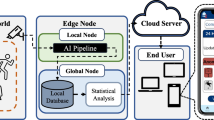Abstract
With the mass deployment of cameras, concern has risen about protecting a person’s privacy as he goes about his daily life. Many of the cameras are installed to perform surveillance tasks that do not require the identity of a person. In the context of surveillance applications, we examine the trade-off between privacy and security. The trade-off is accomplished by looking at quantitative measures of privacy and surveillance performance. To provide privacy protection we examine the effect on surveillance performance of a parametric family of privacy function. A privacy function degrades images to make identification more difficult. By varying the parameter, different levels of privacy protection are provided. We introduce the privacy operating characteristic (POC) to quantitatively show the resulting trade-off between privacy and security. From a POC, policy makers can select the appropriate operating point for surveillance systems with regard to privacy.
Preview
Unable to display preview. Download preview PDF.
Similar content being viewed by others
References
Turk, M., Pentland, A.: Eigenfaces for recognition. J. Cognitive Neuroscience 3, 71–86 (1991)
Newton, E., Sweeney, L., Malin, B.: Preserving privacy by de-identifying facial image. IEEE trans. Knowledge and Data Engineering 17, 232–243 (2005)
Phillips, P.J., Moon, H., Rizvi, S., Rauss, P.: The FERET evaluation methodology for face-recognition algorithms. IEEE Trans. PAMI 22, 1090–1104 (2000)
Kirby, M., Sirovich, L.: Application of the karhunen-loeve procedure for the characterization of human faces. IEEE Trans. PAMI 12, 103–108 (1990)
Moon, H., Phillips, P.J.: Computational and performance aspects of PCA-based face-recognition algorithms. Perception 30, 303–321 (2001)
Author information
Authors and Affiliations
Editor information
Editors and Affiliations
Rights and permissions
Copyright information
© 2005 Springer-Verlag Berlin Heidelberg
About this paper
Cite this paper
Phillips, P.J. (2005). Privacy Operating Characteristic for Privacy Protection in Surveillance Applications. In: Kanade, T., Jain, A., Ratha, N.K. (eds) Audio- and Video-Based Biometric Person Authentication. AVBPA 2005. Lecture Notes in Computer Science, vol 3546. Springer, Berlin, Heidelberg. https://doi.org/10.1007/11527923_91
Download citation
DOI: https://doi.org/10.1007/11527923_91
Publisher Name: Springer, Berlin, Heidelberg
Print ISBN: 978-3-540-27887-0
Online ISBN: 978-3-540-31638-1
eBook Packages: Computer ScienceComputer Science (R0)




